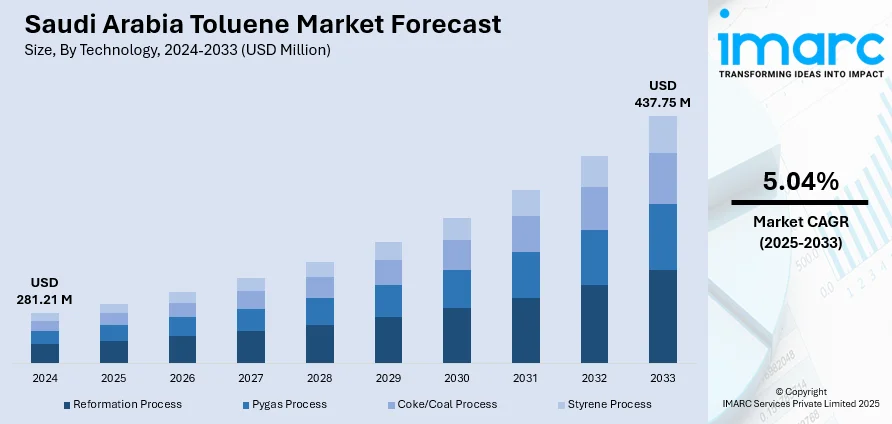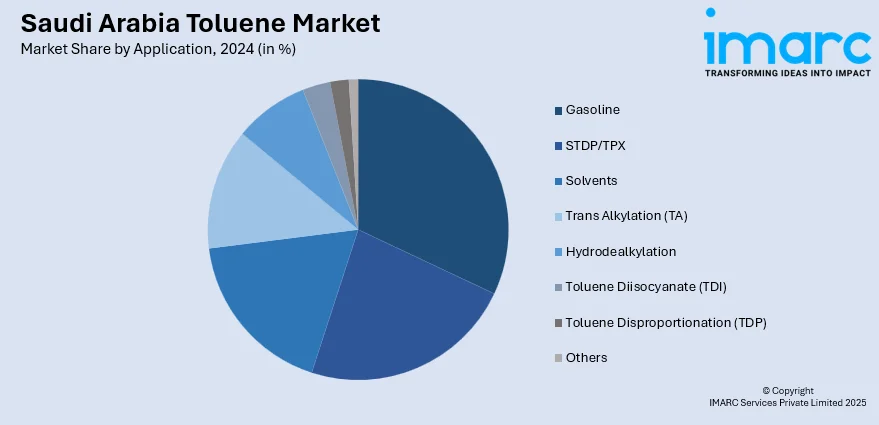
Saudi Arabia Toluene Market Size, Share, Trends and Forecast by Technology, Application, and Region, 2025-2033
Saudi Arabia Toluene Market Overview:
The Saudi Arabia toluene market size reached USD 281.21 Million in 2024. Looking forward, IMARC Group expects the market to reach USD 437.75 Million by 2033, exhibiting a growth rate (CAGR) of 5.04% during 2025-2033. The rising demand from downstream industries, including paints, coatings, adhesives, and chemicals, and the growing construction and infrastructure activities across the region are driving market growth. In addition to this, the expansion of petrochemical complexes and the implementation of supportive government initiatives to diversify the economy under Vision 2030 are some of the major factors augmenting Saudi Arabia toluene market share.
|
Report Attribute
|
Key Statistics
|
|---|---|
|
Base Year
|
2024 |
|
Forecast Years
|
2025-2033
|
|
Historical Years
|
2019-2024
|
| Market Size in 2024 | USD 281.21 Million |
| Market Forecast in 2033 | USD 437.75 Million |
| Market Growth Rate 2025-2033 | 5.04% |
Saudi Arabia Toluene Market Trends:
Expansion of Petrochemical Integration
Saudi Arabia is rapidly strengthening its position in the global market through an aggressive push toward refining and petrochemical integration. Major market players such as SABIC and Aramco are focusing on consolidating operations across the value chain to improve feedstock efficiency and enhance the production of key aromatics. Toluene, derived as a by-product of catalytic reforming and steam cracking, is benefiting directly from this vertical integration. For instance, on April 11, 2025, Saudi Aramco, Sinopec, and Yasref signed a Venture Framework Agreement to advance a major petrochemicals expansion at the Yasref refinery in Yanbu, Saudi Arabia. The project supports Aramco's strategy to reach 4 million b/d of liquids-to-chemicals conversion capacity by 2030. As integrated complexes become operational, a stable supply of aromatics, including toluene, is emerging, ensuring price stability and feedstock security for downstream manufacturers. These developments are particularly vital for toluene's derivatives like benzene, xylene, and toluene diisocyanate (TDI), which serve critical roles in industries such as automotive, construction, and consumer goods. Additionally, the promotion of specialty chemical clusters in Saudi Arabia's industrial zones is encouraging domestic consumption of toluene rather than relying heavily on exports. In addition to this, the implementation of favorable government initiatives under Vision 2030 is supporting joint ventures with international players, further strengthening technological capabilities, and increasing domestic petrochemical output.

Rising Demand from the Construction and Infrastructure Sectors
The expansion of the construction sector across Saudi Arabia is generating substantial demand for toluene-based products, especially paints, coatings, adhesives, and sealants, which is contributing to Saudi Arabia toluene market growth. Moreover, large-scale projects such as NEOM, the Red Sea Development, and the Qiddiya entertainment city are driving the consumption of chemical intermediates where toluene plays a key role. Toluene is essential in the formulation of solvent-based products that offer durability, corrosion resistance, and improved finish, characteristics highly valued in extreme desert climates. As per industry reports, urban populations in the Gulf Cooperation Council region are predicted to grow by 30% between 2020 and 2030, increasing the need for infrastructure, housing, and equitable development. In order to handle the expanding population, Saudi Arabia intends to build an additional 500,000 housing units. This rapid urbanization and increasing infrastructure spending further contributes to toluene demand. Furthermore, stricter regulatory standards related to construction quality and material performance are encouraging the use of premium-grade adhesives and coatings, thereby requiring higher purity toluene grades. In addition to traditional applications, emerging sectors like green buildings and smart cities are opening new avenues for advanced chemical formulations where toluene and its derivatives are critical components.
Saudi Arabia Toluene Market Segmentation:
IMARC Group provides an analysis of the key trends in each segment of the market, along with forecasts at the country and regional levels for 2025-2033. Our report has categorized the market based on technology and application.
Technology Insights:
- Reformation Process
- Pygas Process
- Coke/Coal Process
- Styrene Process
The report has provided a detailed breakup and analysis of the market based on the technology. This includes reformation process, pygas process, coke/coal process, and styrene process.
Application Insights:

- Gasoline
- STDP/TPX
- Solvents
- Trans Alkylation (TA)
- Hydrodealkylation
- Toluene Diisocyanate (TDI)
- Toluene Disproportionation (TDP)
- Others
A detailed breakup and analysis of the market based on the application have also been provided in the report. This includes gasoline, STDP/TPX, solvents, trans alkylation (TA), hydrodealkylation, toluene diisocyanate (TDI), toluene disproportionation (TDP), and others.
Regional Insights:
- Northern and Central Region
- Western Region
- Eastern Region
- Southern Region
The report has also provided a comprehensive analysis of all the major regional markets, which include Northern and Central Region, Western Region, Eastern Region, and Southern Region.
Competitive Landscape:
The market research report has also provided a comprehensive analysis of the competitive landscape. Competitive analysis such as market structure, key player positioning, top winning strategies, competitive dashboard, and company evaluation quadrant has been covered in the report. Also, detailed profiles of all major companies have been provided.
Saudi Arabia Toluene Market Report Coverage:
| Report Features | Details |
|---|---|
| Base Year of the Analysis | 2024 |
| Historical Period | 2019-2024 |
| Forecast Period | 2025-2033 |
| Units | Million USD |
| Scope of the Report | Exploration of Historical Trends and Market Outlook, Industry Catalysts and Challenges, Segment-Wise Historical and Future Market Assessment:
|
| Technologies Covered | Reformation Process, Pygas Process, Coke/Coal Process, Styrene Process |
| Applications Covered | Gasoline, STDP/TPX, Solvents, Trans Alkylation (TA), Hydrodealkylation, Toluene Diisocyanate (TDI), Toluene Disproportionation (TDP), Others |
| Regions Covered | Northern and Central Region, Western Region, Eastern Region, Southern Region |
| Customization Scope | 10% Free Customization |
| Post-Sale Analyst Support | 10-12 Weeks |
| Delivery Format | PDF and Excel through Email (We can also provide the editable version of the report in PPT/Word format on special request) |
Key Questions Answered in This Report:
- How has the Saudi Arabia toluene market performed so far and how will it perform in the coming years?
- What is the breakup of the Saudi Arabia toluene market on the basis of technology?
- What is the breakup of the Saudi Arabia toluene market on the basis of application?
- What is the breakup of the Saudi Arabia toluene market on the basis of region?
- What are the various stages in the value chain of the Saudi Arabia toluene market?
- What are the key driving factors and challenges in the Saudi Arabia toluene market?
- What is the structure of the Saudi Arabia toluene market and who are the key players?
- What is the degree of competition in the Saudi Arabia toluene market?
Key Benefits for Stakeholders:
- IMARC’s industry report offers a comprehensive quantitative analysis of various market segments, historical and current market trends, market forecasts, and dynamics of the Saudi Arabia toluene market from 2019-2033.
- The research report provides the latest information on the market drivers, challenges, and opportunities in the Saudi Arabia toluene market.
- Porter's five forces analysis assist stakeholders in assessing the impact of new entrants, competitive rivalry, supplier power, buyer power, and the threat of substitution. It helps stakeholders to analyze the level of competition within the Saudi Arabia toluene industry and its attractiveness.
- Competitive landscape allows stakeholders to understand their competitive environment and provides an insight into the current positions of key players in the market.
Need more help?
- Speak to our experienced analysts for insights on the current market scenarios.
- Include additional segments and countries to customize the report as per your requirement.
- Gain an unparalleled competitive advantage in your domain by understanding how to utilize the report and positively impacting your operations and revenue.
- For further assistance, please connect with our analysts.
 Request Customization
Request Customization
 Speak to an Analyst
Speak to an Analyst
 Request Brochure
Request Brochure
 Inquire Before Buying
Inquire Before Buying




.webp)




.webp)












